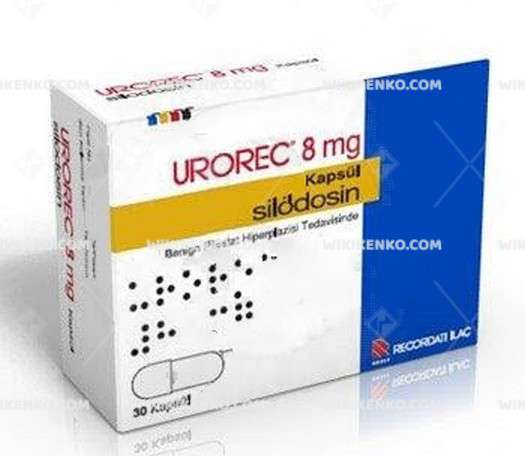Urorec Capsule 8 Mg
Urorec is a pharmaceutical solution designed to address the distressing symptoms associated with benign prostatic hyperplasia (BPH), commonly characterized by an enlarged prostate gland. Each capsule of Urorec contains the active substance silodosin.
| Dosage form | |
|---|---|
| Pack size | |
| Potency | 8 Mg |
| Manufacturer | |
| Origin | |
| Generic Name (Ingredient) | Silodosin 8 Mg |
Assuming your emergency circumstances for this product, visit Urgent Quotation page. Besides, for any pharmaceutical questions, please ask us in the comments section.
Description
Understanding BPH and Its Symptoms
Benign prostatic hyperplasia entails the non-cancerous enlargement of the prostate gland, situated at the base of the male bladder. This expansion can disrupt the normal flow of urine, leading to bothersome urinary symptoms.
Dosage and Administration
The recommended dosage of Urorec Capsule 8 mg is one capsule per day. However, for individuals with moderate kidney issues, the initial dose is 4 mg once daily, which may be adjusted to 8 mg per day after a week. It’s important to note that Urorec is not suitable for patients with severe kidney problems. To ensure optimal effectiveness, take the capsules with food at a consistent daily time, and swallow them whole with a glass of water.
Mechanism of Action
Silodosin, the active component within Urorec, acts as an alpha-adrenoreceptor antagonist. This mechanism revolves around the blocking of alpha1A adrenoreceptors in the prostate gland, bladder, and urethra (the tube connecting the bladder to the exterior of the body). Activation of these receptors typically induces the contraction of muscles that regulate urine flow. By inhibiting these receptors, silodosin facilitates muscle relaxation, easing the passage of urine and alleviating BPH symptoms.
Side Effects
Urorec may induce specific side effects, including:
- Reduced Semen Volume: A common side effect with Urorec, where the amount of semen released during ejaculation may decrease.
- Intraoperative Floppy Iris Syndrome (IFIS): This condition can occur in some patients taking alpha-adrenoreceptor antagonists and may lead to complications during cataract surgery.
- Additional Adverse Reactions: These may encompass dizziness, diarrhea, orthostatic hypotension (a drop in blood pressure when transitioning from sitting or lying to standing), headache, nasopharyngitis (inflammation of the nose and throat), and nasal congestion.
It is essential to acknowledge that this list does not encompass all potential side effects. Some individuals may experience effects not listed here. Should you encounter any unusual symptoms, seek guidance from a healthcare professional.
Availability and Onset of Action
Urorec Capsule 8 mg is available in packs containing 30 capsules and is exclusively dispensed through pharmacies. As for its onset of action, Urorec, containing silodosin, demonstrates rapid efficacy. Many users experience relief from lower urinary tract symptoms within two to six hours after ingestion. Nonetheless, it’s prudent to consult a healthcare professional for personalized advice, as individual responses may vary.
Precautions and Storage Guidelines
To ensure safe usage of Urorec, consider the following precautions:
- Dosage for Kidney Problems: If you have moderate kidney problems, commence with a 4 mg daily dose. After a week, this may be increased to 8 mg per day. However, severe kidney problems contraindicate the use of Urorec.
- Food and Water: Consume Urorec capsules with food, ideally at the same time each day, and swallow them whole with a glass of water.
- Alcohol Consumption: Limit or avoid alcoholic beverages while taking it.
- Driving and Operating Machinery: Exercise caution, as it may cause dizziness or reduced alertness in some individuals.
- Storage: Keep it below 25 degrees Celsius in its original container. Shield it from light and moisture.
- Medical Advice: Consult a healthcare professional for guidance on medication use and adhere strictly to their instructions.
Pregnancy and Breastfeeding Considerations
Urorec is not intended for use in women. While an embryo/fetal study in rabbits revealed decreased maternal body weight at high doses, no significant teratogenicity was observed. It’s advisable to consult a healthcare professional for guidance regarding medication use during pregnancy or breastfeeding.
Can Urorec Cause Vision Problems?
While Urorec itself typically does not directly cause vision problems, it’s crucial to inform your eye specialist if you are using or have previously used it. This disclosure is vital to preempt any potential complications during cataract surgery, as it can lead to a condition known as Intraoperative Floppy Iris Syndrome (IFIS).
Conclusion
In summary, Urorec Capsule 8 mg, featuring silodosin as its active ingredient, emerges as a pivotal resource in managing the vexing symptoms of benign prostatic hyperplasia. However, adherence to recommended precautions, dosage guidelines, and consultation with healthcare professionals are paramount. If any side effects or concerns arise, promptly consult a healthcare provider for guidance and appropriate management.
At a glance
| Medication | Urorec Capsule 8 Mg |
|---|---|
| Composition | Silodosin (Active Substance) |
| Clinical Application | Benign Prostatic Hyperplasia (Enlarged Prostate) |
| Dosage and Administration | – 8 mg Capsule Once Daily – 4 mg for Moderate Kidney Issues – Avoid for Severe Kidney Problems |
| Mechanism of Action | Alpha-Adrenoreceptor Antagonist |
| Potential Side Effects | – Reduced Semen Volume – IFIS (Intraoperative Floppy Iris Syndrome) – Dizziness – Diarrhea – Orthostatic Hypotension – Headache – Nasopharyngitis – Nasal Congestion |
| Availability | Packs of 30 Capsules (Pharmacies Only) |
| Precautions | – Dosage Adjustment for Kidney Problems – Food and Water Intake – Alcohol Limitation – Caution in Driving and Operating Machinery – Storage Conditions |
| Pregnancy & Breastfeeding Considerations | Not indicated for use in women |
Use the form below to report an error
Please answer the questions as thoroughly and accurately as possible. Your answers will help us better understand what kind of mistakes happen, why and where they happen, and in the end the purpose is to build a better archive to guide researchers and professionals around the world.
The information on this page is not intended to be a substitute for professional medical advice, diagnosis, or treatment. always seek the advice for your physician or another qualified health provider with any questions you may have regarding a medical condition. Always remember to
- Ask your own doctor for medical advice.
- Names, brands, and dosage may differ between countries.
- When not feeling well, or experiencing side effects always contact your own doctor.
Cyberchondria
The truth is that when we’re sick, or worried about getting sick, the internet won’t help.
According to Wikipedia, cyberchondria is a mental disorder consisting in the desire to independently make a diagnosis based on the symptoms of diseases described on Internet sites.
Why you can't look for symptoms on the Internet
If diagnoses could be made simply from a textbook or an article on a website, we would all be doctors and treat ourselves. Nothing can replace the experience and knowledge of specially trained people. As in any field, in medicine there are unscrupulous specialists, differences of opinion, inaccurate diagnoses and incorrect test results.




Reviews
There are no reviews yet.